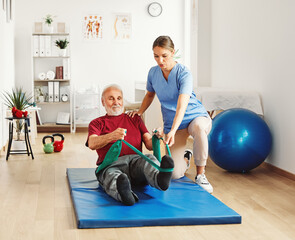Working with disabled clients can be incredibly rewarding on both a physical and psychological level. This is especially true when a trainer can use fitness training to help their clients overcome obstacles in everyday life.
If your client has a wheelchair, try simple cardio exercises like air punching or playing activity-based video games that can be done while seated. You can also find rowing or arm-bicycle machines accessible to people with disabilities. Click https://dynamicpersonaltrainingnj.com/ to learn more.

People with disabilities who exercise regularly experience greater health benefits than their peers who don’t, according to research. Regular physical activity helps people with disabilities maintain a good weight, boosts energy, improves mood, increases mobility, and reduces pain and stiffness. It can also help prevent depression and cognitive problems. Adults with disabilities should start by figuring out their favorite types of exercise and finding the easiest way to incorporate them into their daily lives. They should also consult their doctors or therapists about what is safe for them to do.
Aerobic exercises increase heart and breathing rates, thus bringing more oxygen to the muscles. Those with disabilities can do aerobics in various ways, including swimming, walking, dancing, using upper body ergometers, pushing their wheelchair at a higher speed, and many other activities.
The key to success in aerobics is to increase the workload gradually. People should aim for at least 20 to 30 minutes of moderate-intensity activity five or more days a week. To determine the intensity level, a person should measure their heart rate at the carotid artery by placing the index and middle fingers on the neck and counting for 15 seconds. Then, multiply this number by four to get the heart rate in beats per minute (bpm).
Getting into a workout routine can be intimidating for some adults with disabilities. They may worry about looking different, falling, or hurting themselves. They might also feel a lack of support from friends and family or struggle to find an activity suitable for their disability.
Exercise can be a great way to overcome these fears and build confidence. It can be done at home, in the community, or gyms with special equipment and adapted workout routines. It is important to let a doctor, physiotherapist, or therapist know that a disabled person plans to start a regular exercise pattern so they can help design the best fitness training options.
In addition to aerobics, people with disabilities must also engage in some strength training exercises. This exercise builds muscle and bone mass, helps prevent falls, and strengthens the core and legs. It’s also possible for those with disabilities to use equipment that allows them to do arm-bicycling or rowing without moving their legs. Some gyms and swimming pools even have special wheelchair-training machines that enable people to perform cycling-like exercises while seated comfortably in a chair. Bicep curls are a simple but effective strength-training exercise that can be done with or without weights.
Many people with disabilities believe that a workout is impossible for them, but the truth is that it is not. With the right equipment, training, and motivation, people with disabilities can perform several fitness-related exercises that make them feel strong and healthy. These exercises include walking, cycling, dancing, swimming, water aerobics, or “aqua jogging.”
Depending on their level of disability, people with disabilities can choose cardiovascular or strength-training workouts. Cardiovascular exercises burn calories and improve heart health. They can also help strengthen muscles and improve posture and balance. This can reduce the risk of falls in people with locomotor disabilities and increase mobility in wheelchair users.
In addition, cardiovascular exercises can help lower blood pressure and improve mood. They can also stimulate the release of endorphins, which can help alleviate depression and anxiety in some people with disabilities. Exercise is not just good for the body; it can also be a great social activity, as it allows people with disabilities to meet others in similar situations.
People with disabilities must find an exercise program that suits their ability levels. They should begin by deciding on their favorite type of exercise and then finding an easy way to incorporate it into their daily routine. It may take a few months to turn exercise into an automatic behavior, so they should be encouraged if they do not see results immediately. It is also important for them to drink plenty of water and to stop exercising if they experience physical discomfort.
The RESID (Resistance Exercise Set for Adults with Intellectual Disabilities) was developed to provide resistance training workouts for people with intellectual disabilities. These exercises can be performed without weight machines and are tailored to each person’s physical capabilities. Those with intellectual disabilities can benefit from this type of workout because it gives them a sense of control and accomplishment and helps promote a positive self-image.
However, those with intellectual disabilities must ensure they are properly supervised during the exercise session, as they can easily become bored. It is also recommended that their caregivers accompany them to provide support and encouragement. Ultimately, a combination of these measures will help maximize the workout’s benefits for those with intellectual disabilities. This can be done by working with a trainer or fitness professional with the knowledge and skills to create an effective program, allowing individuals to achieve the best results possible. This includes the use of the proper techniques, as well as the correct posture and positioning during the workout. This will allow them to develop the most effective individualized strength-training routine for each person. Proper posture during the exercise will also minimize stress and prevent injury. To maximize the effectiveness of the workout, it is also advisable to focus on strengthening the antagonist muscle groups, which oppose the muscles responsible for spasticity and primitive reflex patterns.